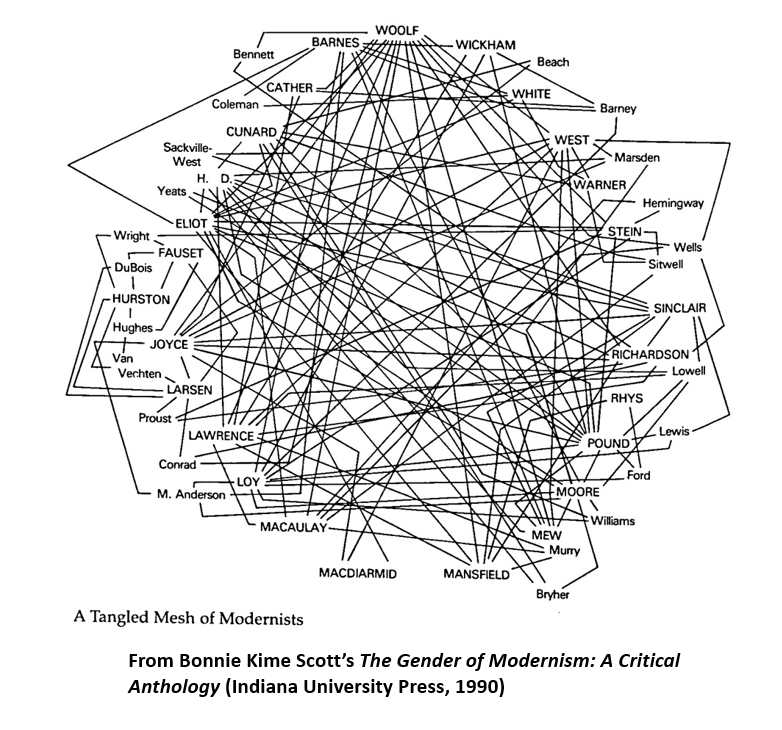This is a guest post by Dr. Chris Worth.
One of the topics raised in the question time after Benjamin Andréo’s first lecture on Dada and Surrealism was a really good one about whether, despite their avant-garde aspirations, many of the key figures in the movements continued to take a very male-oriented to art and seem to have made little attempt to respond to pressures from women to play a larger role:
Whilst surrealist thought radically challenged hierarchies, it often remained blind to its own gender politics, locked in a heterosexual, sometimes homophobic, patriarchal stance positioning and constructing women (and never men) as artists’ muses, femme-enfants, virgins, dolls and erotic objects. As Gwen Raaberg points out ‘no women [. . .] had been listed as official members of the surrealist movement, nor had they signed the manifestoes’. (Patricia Allmer, Angels and Anarchy, 13)
Photographs of ‘the Surrealists’ usually represent a collection of men with one or two often relegated to the edges of the group (although the photograph from the first Surrealist exhibition in London in 1936 is an interesting exception:

Over the last few decades this issue has been a significant research issue in the fields of art history, literature, etc. There have been some really interesting studies published – here are a couple that are worth looking at, particularly valuable for demonstrating how the ideas of the movement led to some spectacularly interesting art work by women:
Allmer, Patricia (ed.). Angels of Anarchy: Women Artists and Surrealism. Manchester and Munich: Manchester Art Gallery/Prestel, 2009. Caulfield 709.04063 A439A 2009
Catalogue of an exhibition at the Manchester Art Gallery, 29 Sept. 2009 – 10 Jan. 2010. Contains a number of short essays, including ones by Mary Ann Caws, Katherine Conley and Alyce Mahon, but more importantly illustrations of amazing work by Eileen Agar, Claude Cahun and Dora Maar (from the pre-WWII period), as well as the continuing influence of surrealist thought and methods in the work of more recent female artists like Francesca Woodman. I think Cahun is particularly interesting – photographer and performer – see below for her prose self-representation.
Cahun, Claude. Disavowals: or, Cancelled Confessions. Trs. Susan de Muth. London: Tate Publishing, 2007. [1930, as Aveux non Anvenus]. Caulfield Call no:848.91209 CAH (NB, the American ed. publ. by MIT Press)
Caws, Mary Ann, Rudolf Kuenzil and Gwen Raaberg (eds). Surrealism and Women. Cambridge, MA: MIT Press, 1991. Clayton – Matheson 709.04066 C383S (also at Caulfield)
Chadwick, Whitney. Women Artists and the Surrealist Movement. London: Thames & Hudson, 1998. Clayton – Matheson 709.04066 C432W (also at Caulfield)
Chadwick, Whitney and Dawn Ades. Mirror Images: Women, Surrealism, and Self-representation. Cambridge, MA: MIT Press, 1998. Clayton – Matheson 704.042 C432M (also at Caulfield).
Catalogue of an exhibition at the MIT List Visual Arts Center, the Miami Art Museum and the San Francisco Museum of Modern Art.
Conley, Katherine. Automatic Women: The Representation of Women in Surrealism. Lincoln: U of Nebraska P, 1996. Caulfield 709.04063 C752A 1996
Mahon, Alyce. Surrealism and the Politics of Eros, 1938-1968. London: Thames & Hudson, 2005. Clayton – Matheson 709.44 M216S 2005 (also at Caulfield)
Van Raay, Stefan, Joanna Morehead, and Teresa Arcq. Surreal Friends: Leonora Carrington, Remedios Varo and Kati Horna. Franham, Surrey: Lund Humphries in association with Pallant House Gallery, 2010. Not in the Monash libraries, alas, but I am prepared to lend the book to anyone who is madly interested in the topic (great illustrations).
Of course the much bigger question is the one that needs to be addressed to modernism as a whole: do the revolutionary artistic sentiments of modernism acknowledge and address the condition of women in art and life? (Hard for Australians to remember, but women did not get the vote in France until 1944, for example – 1918 in Britain, for women who owned property and were over 30 . . .) I know that this will come up with Virginia Woolf, if not before, but I would also like to point to the interesting diagram about relationships between modernists, taken from Bonnie Kime Scott’s The Gender of Modernism: A Critical Anthology (Indiana University Press, 1990), that is slide 4 in Melinda’s lecture from 2014:

I have left it on the Moodle site in the Dubliners section – obviously I won’t give the same lecture as Melinda did, but much of the material is fascinating and I will refer to most of it.
Chris Worth